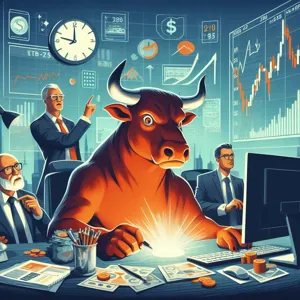Navigating the world of investing can often feel like trying to predict the weather—unpredictable and ever-changing.
One of the most important concepts for investors to grasp is the idea of a bull market, a period characterized by rising stock prices and widespread optimism. Understanding what defines a bull market, the factors that drive it, and how long these upward trends typically last can empower you to make smarter investment decisions and better manage your portfolio. In this comprehensive guide, we’ll break down the essentials of bull markets, explore historical patterns, and offer insights into how you can recognize and respond to these pivotal phases in the financial landscape.
1. Introduction to Bull Markets

A bull market is a financial market condition characterized by rising asset prices, generally accompanied by investor optimism, confidence, and expectations that strong results will continue. The term “bull market” is most commonly used in the context of stock markets, but it can apply to any market where prices are moving upward over a sustained period, including real estate, commodities, and cryptocurrencies. Understanding what drives bull markets, their typical duration, and how they impact investment strategies is essential for both new and experienced investors. In this section, we’ll explore the basic definition of a bull market, the key indicators that signal its presence, and why recognizing these trends early can help you make more informed financial decisions.
2. Defining a Bull Market: Key Characteristics
A bull market is characterized by a prolonged period of rising asset prices, typically reflecting investor confidence, optimism, and strong economic fundamentals. During a bull market, stock prices generally rise by 20% or more from recent lows, signaling a positive trend in the market. This upward momentum is often fueled by factors such as increasing corporate profits, low unemployment rates, favorable interest rates, and robust consumer spending. Investors tend to be more willing to buy and hold securities, anticipating further gains. Additionally, bull markets are marked by high trading volumes and widespread participation across various sectors. Understanding these key characteristics helps investors recognize the onset of a bull market and make informed decisions to capitalize on upward trends.
3. Historical Examples of Bull Markets

Throughout history, bull markets have played a significant role in shaping investor sentiment and economic growth. These periods, characterized by sustained increases in stock prices, often reflect strong investor confidence and favorable economic conditions. One of the most notable bull markets occurred during the 1990s, fueled by the rise of technology companies and the dot-com boom. This era saw the Nasdaq Composite Index surge dramatically, driven by investor enthusiasm for internet-based businesses.
Another prominent example is the bull market that followed the 2008 financial crisis. Beginning in March 2009, this rally lasted over a decade, becoming one of the longest in history. Supported by low interest rates, quantitative easing, and a recovering economy, the market steadily climbed, rewarding long-term investors.
Looking further back, the post-World War II bull market from 1949 to 1961 also stands out. This period was marked by rapid industrial growth, increased consumer spending, and innovation, which propelled stock prices higher over more than a decade.
These historical examples illustrate that while bull markets can vary in duration—ranging from several years to over a decade—they typically coincide with periods of economic expansion and positive investor outlooks. Recognizing these patterns can help investors make more informed decisions about entering or exiting the market during different phases of the economic cycle.
4. What Causes Bull Markets?
Bull markets are driven by a combination of factors that create an environment of optimism and rising investor confidence. One of the primary causes is strong economic growth, often indicated by rising GDP, low unemployment rates, and increasing corporate earnings. When companies report healthy profits and positive future outlooks, investors are more willing to buy stocks, pushing prices higher. Additionally, favorable monetary policies, such as low interest rates and quantitative easing by central banks, make borrowing cheaper and encourage investment in equities rather than fixed-income assets. Investor sentiment also plays a crucial role; when the market mood is optimistic, more participants enter the market, fueling demand and further price increases. Other contributing factors can include technological innovation, geopolitical stability, and increased consumer spending. Understanding these drivers can help investors better anticipate the emergence and sustainability of bull markets.
5. How to Identify the Start of a Bull Market

Identifying the start of a bull market can be both an art and a science, requiring a keen eye on various economic indicators and market signals. Typically, a bull market begins when investor confidence starts to build after a period of market downturn or stagnation. One of the earliest signs is a sustained rise in stock prices across multiple sectors, accompanied by increased trading volume. Economic indicators such as rising GDP, lower unemployment rates, and improving corporate earnings often reinforce this positive momentum. Additionally, market sentiment surveys and investor behavior, like increased buying activity and reduced volatility, can provide clues that a bull market is taking shape. It’s important for investors to look beyond short-term market fluctuations and focus on these broader trends to better time their entry and capitalize on the growth phase of the market.
6. Typical Duration of Bull Markets: An Overview
Bull markets, characterized by sustained increases in stock prices and overall investor optimism, can vary widely in their duration. Historically, the length of a bull market depends on a range of economic factors, including interest rates, corporate earnings, and geopolitical events. On average, bull markets tend to last anywhere from several months to several years. For instance, some of the longest bull markets in history, such as the one from 2009 to 2020, lasted over a decade, fueled by strong economic growth and accommodative monetary policies. Conversely, shorter bull markets may only persist for a few months before a market correction or bear market sets in. Understanding these typical durations helps investors set realistic expectations and strategize their investment plans accordingly, rather than reacting impulsively to short-term market fluctuations.
7. Factors Influencing the Length of Bull Markets

The duration of a bull market is influenced by a complex interplay of economic, political, and psychological factors. One of the primary drivers is economic growth; when the economy is strong, corporate earnings tend to rise, fueling investor confidence and sustaining upward momentum in the markets. Conversely, economic slowdowns or recessions can shorten bull markets as investors become more cautious.
Monetary policy also plays a critical role. Central banks’ decisions on interest rates and quantitative easing can either extend a bull market by maintaining liquidity and encouraging borrowing or trigger its end if tightening measures are introduced to curb inflation. Additionally, geopolitical events—such as elections, trade tensions, or conflicts—can create uncertainty that affects investor sentiment and the market’s trajectory.
Investor psychology cannot be overlooked. Bull markets often gain strength as optimism and fear of missing out drive more participants to buy into rising markets. However, excessive exuberance can lead to overvaluation, eventually causing a market correction or downturn that ends the bull phase.
Understanding these factors helps investors better anticipate the potential length of a bull market and make more informed decisions about when to enter or exit positions. While no two bull markets are exactly alike, recognizing these influences provides valuable context for navigating the ever-changing landscape of financial markets.
8. Comparing Bull Markets Across Different Asset Classes
When examining bull markets, it’s essential to recognize that their characteristics can vary significantly across different asset classes such as stocks, real estate, commodities, and cryptocurrencies. Each asset class responds to unique economic drivers, investor sentiment, and market dynamics, which influences both the magnitude and duration of their bullish phases.
For instance, stock market bull runs are often fueled by strong corporate earnings, low interest rates, and positive economic outlooks. Historically, these bull markets tend to last several years—sometimes even a decade—before giving way to a correction or bear market. Real estate bull markets, on the other hand, can be prolonged due to slower-moving supply and demand factors, often spanning multiple economic cycles, but they may also be more regionally concentrated.
Commodities experience bull markets that are frequently tied to global supply constraints, geopolitical events, or shifts in demand from emerging markets. These cycles can be shorter but extremely volatile, reflecting the sensitivity of commodities to external shocks. Meanwhile, cryptocurrency bull markets are relatively new and tend to be more speculative and shorter-lived, often marked by rapid price surges followed by sharp declines.
By comparing these different asset classes, investors can better understand the unique risks and opportunities each bull market presents. Diversifying across asset types can also help mitigate the impact of a downturn in any single market, enabling a more balanced and resilient investment strategy over time.
9. The Role of Investor Sentiment in Bull Markets
Investor sentiment plays a crucial role in shaping the dynamics of bull markets. At its core, investor sentiment refers to the overall attitude and emotions of market participants toward the financial markets or specific assets. During a bull market, optimism tends to be widespread, with investors feeling confident about future economic growth and corporate earnings. This positive outlook often leads to increased buying activity, driving prices higher and fueling the upward momentum.
As investor sentiment becomes increasingly bullish, it can create a self-reinforcing cycle: rising prices boost confidence, which in turn encourages more investment, further pushing prices up. However, this exuberance can sometimes lead to overvaluation, where asset prices detach from their fundamental values. Understanding this psychological aspect of the market is essential because shifts in sentiment can signal changes in market trends. For example, if investors suddenly become cautious or fearful due to economic uncertainties or geopolitical events, the bull market may lose steam or even reverse.
In summary, investor sentiment acts as both a catalyst and a barometer during bull markets. By keeping an eye on how investors feel and react, traders and long-term investors alike can better anticipate potential turning points and make more informed decisions.
10. Common Strategies for Investing During Bull Markets
During bull markets, when prices are rising and investor confidence is high, many investors adopt specific strategies to maximize gains while managing risks. One common approach is to focus on growth stocks—companies expected to expand at an above-average rate compared to their industry or the overall market. These stocks often outperform during bullish trends as optimism drives demand.
Another popular strategy is to increase exposure to cyclical sectors such as technology, consumer discretionary, and financials, which tend to benefit from economic expansion. Investors might also use a “buy and hold” approach during bull markets, capitalizing on the general upward momentum without frequent trading.
Additionally, some investors practice dollar-cost averaging, consistently investing a fixed amount regardless of market conditions, which can help smooth out the impact of short-term volatility within the broader upward trend.
However, it’s important to remain vigilant and set clear exit points or stop-loss orders to protect profits, as bull markets can shift unexpectedly. Diversifying your portfolio and staying informed about market indicators can further enhance your ability to navigate these optimistic but often unpredictable environments successfully.
11. Risks and Warning Signs to Watch For
While bull markets often bring optimism and rising asset prices, it’s crucial for investors to remain vigilant and aware of the risks and warning signs that may signal an impending downturn. One key risk is overvaluation—when stock prices rise too quickly and exceed the underlying economic fundamentals, it creates a bubble that can burst unexpectedly. Pay close attention to price-to-earnings ratios and other valuation metrics to assess whether the market is becoming overheated.
Another warning sign is excessive investor euphoria. When market sentiment becomes overwhelmingly positive, with widespread speculation and herd behavior, it often precedes a correction. Additionally, macroeconomic factors such as rising interest rates, inflation spikes, geopolitical tensions, or unexpected changes in monetary policy can disrupt market momentum and trigger sell-offs.
Keep an eye on market breadth—the number of stocks advancing versus declining. A narrowing market where gains are concentrated in only a few sectors or companies may indicate weakening underlying strength. Finally, sudden increases in volatility and a shift in trading volumes can signal growing uncertainty.
By staying informed and recognizing these risks and warning signs early, investors can better prepare their portfolios to weather potential downturns and make more strategic decisions during bull markets.
12. How Bull Markets End: Transitioning to Bear Markets
Bull markets, characterized by sustained increases in stock prices and investor optimism, don’t last forever. Eventually, they reach a turning point where the upward momentum slows and reverses, leading to a transition into a bear market. Understanding how bull markets end can help investors prepare and adjust their strategies accordingly.
Typically, the end of a bull market is marked by a combination of factors such as overvaluation of stocks, rising inflation, tightening monetary policies by central banks, and shifts in economic fundamentals. Investor sentiment may also begin to shift as market participants grow cautious, leading to increased volatility and a slowdown in buying activity.
One common sign of a bull market nearing its end is when valuations become stretched, with price-to-earnings ratios significantly exceeding historical averages. At this point, stocks may be priced higher than their intrinsic value, making the market vulnerable to corrections. Additionally, external shocks—such as geopolitical tensions, unexpected economic downturns, or financial crises—can accelerate the decline.
As the market enters a bear phase, characterized by falling prices and pessimism, investors often become risk-averse, leading to reduced liquidity and selling pressure. This shift can be gradual or abrupt but marks a clear change in market dynamics.
By recognizing these signals, investors can better position themselves to protect their portfolios during the transition from a bull to a bear market, whether through diversification, hedging strategies, or adjusting asset allocations. Staying informed and attentive to market trends is key to navigating these cycles successfully.
13. Lessons Learned from Past Bull Markets
Examining past bull markets provides valuable insights into their behavior and duration, helping investors make more informed decisions. Historically, bull markets have been driven by strong economic growth, rising corporate earnings, and positive investor sentiment. For instance, the bull market following the early 2000s recession lasted nearly a decade, fueled by technological advancements and accommodative monetary policies. However, no two bull markets are exactly alike—some have been brief but intense, while others have experienced steady, prolonged growth.
One key lesson from past bull markets is the importance of patience and discipline. Investors who stayed the course during market fluctuations often reaped significant rewards over time. Additionally, recognizing the signs of an overheating market, such as overly aggressive valuations or excessive speculative behavior, can help in managing risk and preparing for potential corrections. Ultimately, understanding the patterns and triggers of previous bull markets equips investors with a framework to navigate future market cycles more confidently.
14. The Impact of Economic Indicators on Bull Markets
Economic indicators play a crucial role in shaping the trajectory and longevity of bull markets. These indicators—such as GDP growth rates, unemployment figures, inflation rates, and consumer confidence levels—offer valuable insights into the overall health of the economy. When key economic indicators signal strong growth, low unemployment, and stable inflation, investor confidence typically rises, fueling continued buying momentum in the stock market. For example, a steady increase in GDP suggests businesses are expanding, which often translates to higher corporate earnings and, consequently, rising stock prices. Conversely, if economic data points to slowing growth or rising inflation, it can create uncertainty and prompt investors to become more cautious, potentially slowing down or even ending a bull market. Monitoring these economic signals helps investors anticipate shifts in market sentiment and adjust their strategies accordingly, making economic indicators indispensable tools in understanding and navigating the dynamics of bull markets.
15. Conclusion: Navigating and Capitalizing on Bull Markets
Navigating and capitalizing on bull markets requires a blend of knowledge, strategy, and discipline. Bull markets, characterized by sustained upward trends in stock prices, present lucrative opportunities for investors to grow their portfolios. However, it’s essential to remember that no bull market lasts forever. Understanding the typical duration and phases of a bull market can help you make informed decisions about when to enter, hold, or exit your investments. Staying informed about economic indicators, market sentiment, and company fundamentals will enable you to identify the early signs of both the continuation and eventual end of a bull market. Additionally, maintaining a diversified portfolio and setting clear investment goals can protect you from sudden market reversals while positioning you to benefit from prolonged growth periods. By approaching bull markets with a balanced mindset and strategic planning, you can maximize your returns while minimizing risks, turning these upward trends into lasting financial success.
Understanding bull markets is essential for anyone looking to navigate the world of investing with confidence. By recognizing the characteristics and typical durations of these upward-trending markets, you can make more informed decisions and better time your investments. While no two bull markets are exactly alike, having a solid grasp of their patterns empowers you to seize opportunities and manage risks effectively. We hope this guide has shed light on the dynamics of bull markets and helps you stay ahead in your financial journey. Stay informed, stay patient, and watch your investments grow through the cycles of the market.






